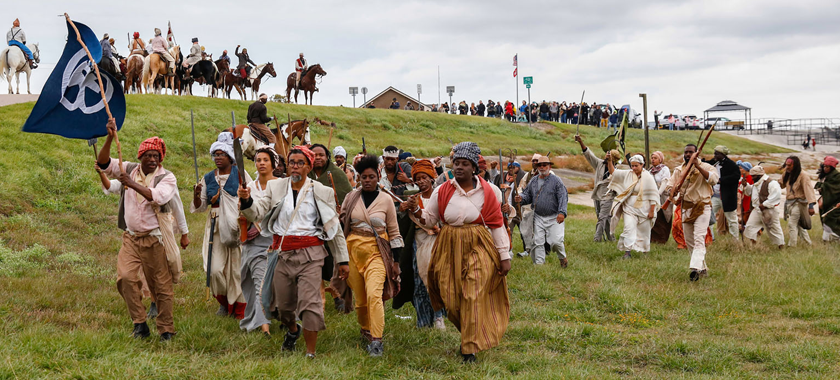
Conversations | Dread Scott on How He Charted His Own Path in the Art World
“I don’t have a dealer, but this work is influential, it’s important. I’m mostly concerned with having the art be something that influences and is part of dialogue.” – NYFA Board Member Dread Scott
NYFA Board Member Dread Scott (Fellow in Sculpture ’01, Performance Art/Multidisciplinary Work ’05, Interdisciplinary Work ’12) makes revolutionary art to propel history forward on his own terms and without an MFA degree or gallery representation. His work is exhibited across the U.S. and internationally, and he recently lent his expertise and had works featured in T: The New York Style Magazine’s “25 Most Influential Works of Protest Art Since World War II” article, which was published this fall. Learn how Scott went from an unknown art student to the center of a national controversy and get insights into his career growth and evolution as an interdisciplinary artist working outside of established art world norms below.
Early Introduction to the Power of Art
As a student at The Art Institute of Chicago, Scott describes not fitting in well in Ronald Reagan and George H.W. Bush’s America; gravitating towards the city’s punk and anti-racist scene; and discovering Hans Haacke and the ideas of Malcolm X and Mao Zedong. He cites Haacke’s strategies for talking about politics and communicating his ideas in a conceptual way as having a big impact on him, in addition to helping him understanding that “…the artwork is not just about what an artist thinks but about engaging the audience and having them involved in the dialogue and discourse of the work itself.” It was during this time, and George H.W. Bush’s campaigning in flag factories, that Scott created the participatory work “What is the Proper Way to Display a U.S. Flag?” to debate and discuss what America represents through the lens of the flag. The work’s transgressive use of the American flag (it was displayed on the ground) became the center of a national controversy, and he later became part of a landmark Supreme Court case when he and others defied the law by burning flags on the steps of the U.S. Capitol. “I was 24 years old and this is how I was introduced to the broader art public,” said Scott. “I realized this work and the ideas in it can change peoples’ minds,” he added. Watch Scott’s TED talk on the topic here.
Career Turning Points and Affirmations
From there, Scott spoke of the 1992 Los Angeles rebellion and how this brought about a turning point that solidified the rest of what “I wanted to do with my art, and understanding again that a lot of the work that needed to be done to talk about America and talk about making revolution and social change in America had to, of necessity, intersect with the conditions of Black people in America and our efforts to get free of this exploitative, oppressive society.” Fast forward to 2001: by that time, Scott had received recognition from Mid Atlantic Arts Foundation, New York State Council on the Arts/New York Foundation for the Arts, Creative Capital, and a number of other organizations. Each gave Scott funding and “a clue that some of my peers actually liked and supported my work;” the Creative Capital grant was the most transformative as it gave Scott professional development including strategic planning that enabled him to go from having success in spite of himself to success that is much more intentional. It also reaffirmed that Scott didn’t have to play by traditional art world rules, following one of two typically-prescribed paths: either getting a MFA degree and becoming a teacher or getting a MFA degree and making commercially viable work for galleries. Scott sells work, and he’d be willing to be represented by the right dealer, but for him, the art is key, not it’s value as a commodity.

Reaching New Audiences
In the years that followed, Scott created works that spoke specifically to the terror that is part of everyday life for Black people including “A Man Was Lynched by Police Yesterday,” which updated the historic NAACP “A Man Was Lynched Today” flag in response to the police killing of Walter Scott. Originally shown at a small gallery in Des Moines, IA in 2015, it became an iconic piece that was later associated with the Black Lives Matter (BLM) movement. It reached a variety of different audiences, going from an art piece to the front page of The New York Times, into The Whitney Museum, onto social media, and then used to accompany a Vogue magazine article by BLM co-founder Patrisse Cullors. The piece illustrates an important tenet in Scott’s work: “the past not only sets the stage for the present, but it resides within the present in new form.”
Success on His Own Terms
Scott has also since shifted his art to not only show oppression in society, but to offer modes of resistance. Which led him towards his most recent project, the “Slave Rebellion Reenactment.” In 2019, the community-engaged artist performance and film production reimagined the German Coast Uprising of 1811, which took place in the river parishes just outside of New Orleans, with hundreds of reenactors in period-specific clothing who marched for two days covering 26 miles. He realized the project without a dealer, and without support that more commercial artists typically receive through established art world networks. In this context, he took inspiration from David Hammons who once said “they need me, I don’t need them,” in response to the art world. In essence: “I don’t have to change what I do to be a critically important artist and have success on my terms.” And though Scott was advised to cut the $1.2 million budget and reduce the scale of his project, he refused to compromise on his vision and was able to successfully complete it through the support of various foundations, art organizations, and individual donors.
Concludes Scott: “I don’t have a dealer, but this work is influential, it’s important. I’m mostly concerned with having the art be something that influences and is part of dialogue. Selling work is great, getting grants is great, but I’m interested in influence and the ideas and aesthetics that I’m interested in working on being part of the discourse in society.”
– Amy Aronoff, Senior Communications Officer
You can find more articles on arts career topics by visiting the Business of Art section of NYFA’s website. Sign up for NYFA News and receive artist resources and upcoming events straight to your inbox. Have an arts career question? You can contact NYFA staff directly by emailing [email protected].